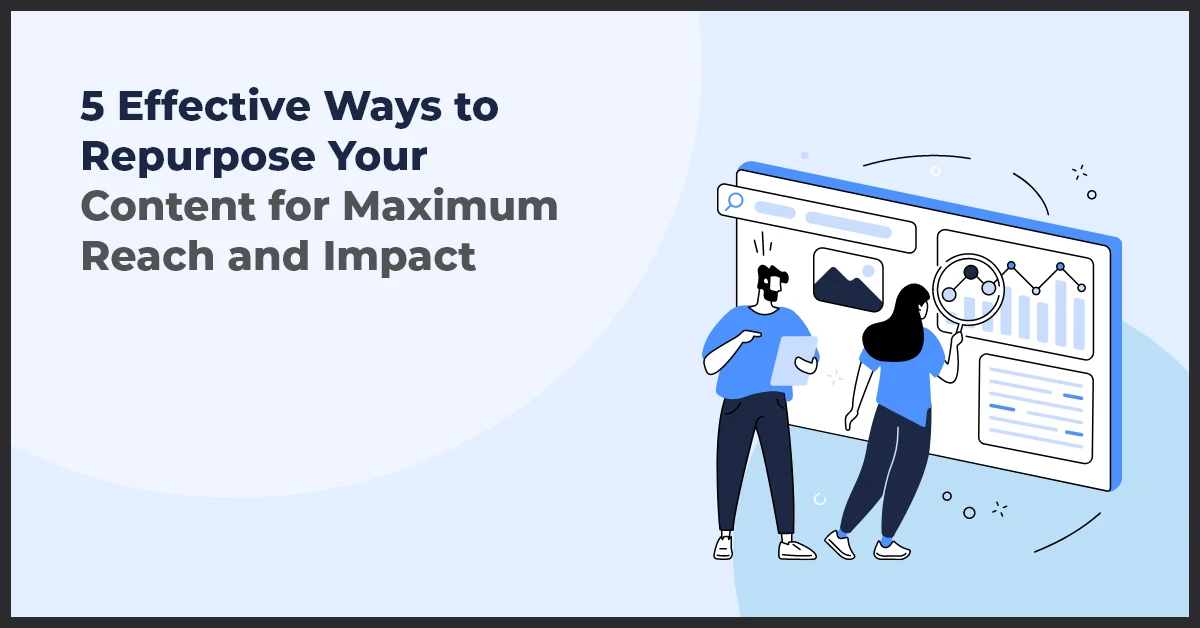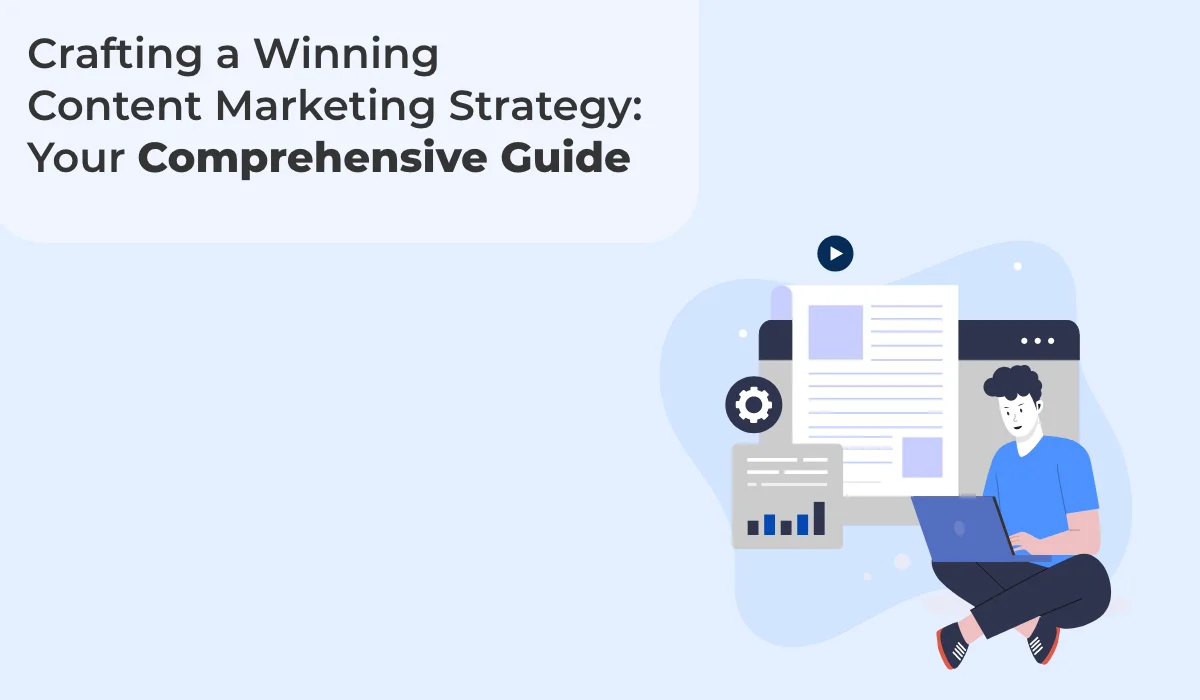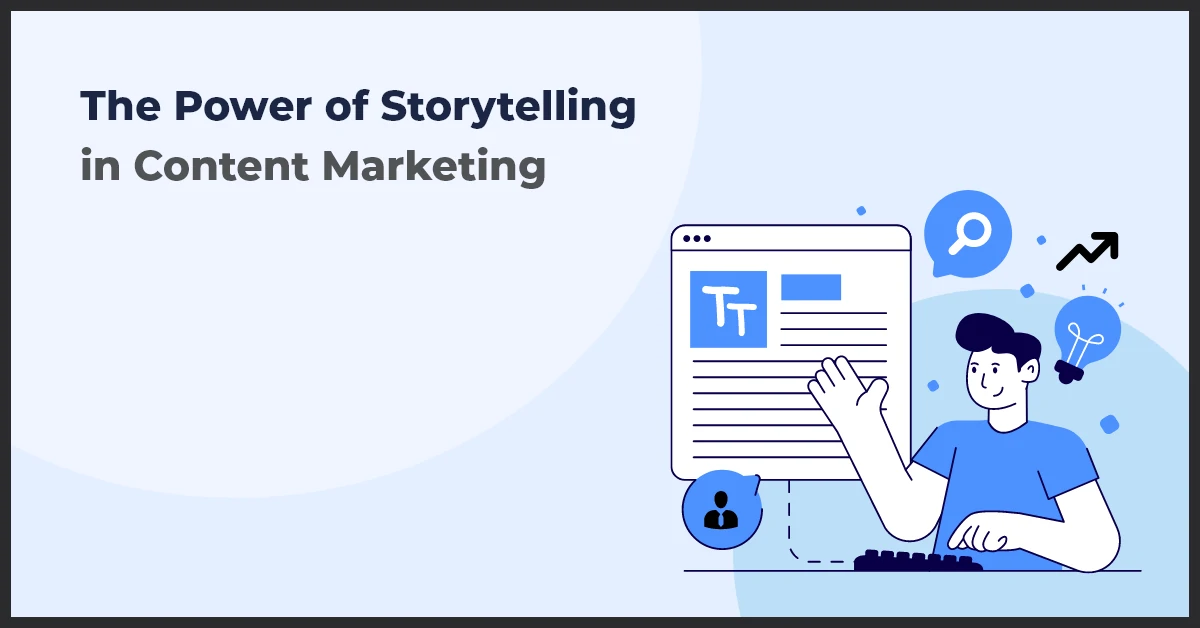5 Effective Ways to Repurpose Your Content for Maximum Reach and Impact

Published on: April 28, 2023
Updated on: July 12, 2024
1895 Views
- Content Marketing
10 min read
Are you tired of creating new content every time you want to reach a new audience or engage with your existing followers? Content repurposing can save you time and effort, while also maximizing your reach and impact. By repackaging your existing content into different formats, you can share it across multiple platforms and appeal to different types of audiences.
In this article, we'll explore 7 effective ways to repurpose your content and get the most out of your existing assets. Whether you're a blogger, marketer, or business owner, these tips will help you reach a wider audience and increase engagement with your content. So, let's get started!
Definition and Importance of Repurposing Content
Repurposing content refers to the process of taking existing content and transforming it into different formats or repackaging it for various channels, reaching a wider audience and maximizing its value. It allows businesses to breathe new life into their valuable assets while saving time and resources.
Benefits of Repurposing Content for Businesses
Repurposing your content offers numerous advantages that can help businesses thrive in today's competitive digital landscape. Firstly, it allows you to extend the reach of your message across different platforms, catering to the preferences of various audience segments. By transforming blog posts into visually engaging infographics or creating podcasts from webinar recordings, you can attract new audiences and boost engagement.
Additionally, repurposing content saves time and effort as you can leverage existing assets instead of starting from scratch. This means you can produce more content within a short span of time, maintaining a consistent presence and keeping your audience engaged. Moreover, repackaging content in diverse formats helps reinforce your brand message, establishing your expertise and credibility in your industry.
In conclusion, repurposing content is a strategic approach that unlocks new growth opportunities for businesses. By breathing new life into your existing content and reaching a wider audience with diverse formats, you can strengthen your brand, attract more customers, and ultimately achieve business success.
Understanding Your Audience
When it comes to content repurposing, understanding your audience is crucial for success. By truly knowing who your target audience is, you can create content that speaks directly to their needs and interests.
Identifying your target audience
The first step in understanding your audience is to identify who they are. Consider demographics such as age, gender, location, and occupation. This information will help you create content that resonates with them on a personal level.
Analyzing their preferences and interests
Once you have identified your target audience, you need to dig deeper and analyze their preferences and interests. What topics are they interested in? What challenges do they face? By understanding their interests and pain points, you can create content that provides value and solutions.
Researching the platforms they frequent and content formats they prefer
Not only is it important to know your audience, but you also need to know where they hang out online. Research the platforms they frequent, such as social media sites, blogs, or forums. Additionally, identify the content formats they prefer, whether it's blog posts, videos, infographics, or podcasts. This information will help you tailor your repurposed content to reach your audience in their preferred formats.
Why Should You Repurpose Your Content
Repurposing your content is a smart strategy for several reasons.
Firstly, it saves you time and effort by allowing you to reuse your existing content in different ways. Rather than constantly creating new content from scratch, you can take advantage of the content you've already created and use it to reach new audiences.
Secondly, content repurposing can help you reach a wider audience. By sharing your content across multiple platforms and in different formats, you can appeal to different types of audiences who may not have seen your content before.
Thirdly, it can increase engagement with your audience. By presenting your content in different formats, you can make it more accessible and engaging to different types of learners. For example, some people may prefer to read a blog post, while others may prefer to watch a video or listen to a podcast.
Finally, content repurposing can help you establish your authority and thought leadership in your industry. By sharing your content in different formats and on different platforms, you can showcase your expertise and build your reputation as a trusted source of information.
Overall, repurposing your content is an effective way to get the most out of your existing content and reach a wider audience with minimal effort.
5 Ways to Repurpose Your Content
1. Social Media
Social media posts are a great way to repurpose your existing content and reach a wider audience on platforms such as Facebook, Twitter, LinkedIn, Instagram, and others. Here are some tips for creating effective social media posts from your existing content:
- Use attention-grabbing headlines: Choose a catchy headline that summarizes the key message of your content and encourages people to click through to read more.
- Create custom graphics: Use tools like Canva or Adobe Spark to create custom graphics with quotes or statistics from your content. This can help make your social media posts more visually appealing and engaging.
- Share snippets: Take key points or quotes from your blog post or article and use them as snippets in your social media posts. Make sure they're short and to the point, so they're easy to read and share.
2. Video Content
Video content has exploded in popularity in recent years, making it a great format to repurpose your existing content. Here are some tips for creating effective videos from your existing content:
- Choose the right type of video: Different types of videos work better for different types of content. For example, explainer videos work well for complex topics, while interviews or webinars are great for showcasing expert opinions.
- Keep it short and sweet: Attention spans are short, so keep your videos concise and to the point. Aim for videos between 2-5 minutes in length, depending on the topic.
- Use visuals to support your message: Use visuals such as graphics, images, and animations to support your message and make the video more engaging.
3. Podcasts
Podcasts are a great way to repurpose your existing content and reach an audience who prefers audio content. Here are some tips for creating effective podcasts from your existing content:
- Choose the right format: Consider what type of podcast format will work best for your content. Options include solo shows, interviews, roundtable discussions, or a combination of formats.
- Focus on audio quality: Since audio is the primary medium for podcasts, it's important to ensure high-quality sound. Invest in a good microphone and recording software to ensure your podcast sounds professional.
- Keep it engaging: Keep your podcast engaging by using a conversational tone and incorporating storytelling. Use music and sound effects to break up segments and add interest.
4. Blog Posts
Repurposing blog content is a brilliant way to turn your existing content and reach a wider audience through your website or other platforms. Here are some tips for creating effective blog posts from your existing content:
- Update and refresh old posts: Go back through your old blog posts and update them with new information, images, or graphics. This can help improve their search engine rankings and keep them relevant.
- Optimize for search engines: Ensure that your blog post is optimized for search engines by using relevant keywords in the title, meta description, and throughout the post. This can help improve its visibility in search engine results.
- Include visuals: Use visuals such as images, infographics, or videos to support your message and make your blog post more engaging.
5. Ebooks
Ebooks are a great way to repurpose your existing content into a comprehensive and visually appealing format that can be downloaded and shared easily. Here are some tips for creating effective ebooks from your existing content:
- Choose a relevant topic: Consider what topics your audience is interested in and choose a relevant topic for your ebook. This could be a collection of related blog posts or an in-depth guide on a particular topic.
- Organize your content: Organize your content into a logical flow that makes sense to your readers. Break your content into chapters or sections and use headings and subheadings to make it easy to navigate.
- Design with visuals: Use visuals such as images, charts, graphs, and infographics to break up the text and make your ebook more visually appealing.
Content Repurposing Techniques
Repurposing your content is a fantastic way to maximize its reach and impact. By taking your existing content and presenting it in different formats, you can engage with new audiences and breathe new life into your messaging. Here are some effective content repurposing techniques:
Repurposing blog posts into different formats
Blogs are a goldmine of information and ideas. By repurposing your blog posts into different formats, you can cater to different learning preferences and reach a wider audience. Consider transforming your blog posts into videos, infographics, or even podcasts. This way, you can present your content in more visually appealing and accessible ways.
Converting whitepapers or case studies into blog posts or emails
Whitepapers and case studies often contain valuable insights and in-depth analyses. However, not everyone has the time to read through lengthy documents. By repurposing these materials into shorter blog posts or emails, you can make your content more digestible and appealing to those who prefer quick reads. This also allows you to highlight the most important points and drive engagement.
Turning videos into blog posts or social media snippets
Videos are a powerful medium for storytelling and engagement. However, not everyone prefers watching videos or may not have the time to watch an entire video. Repurpose your videos into blog posts or social media snippets to cater to these different preferences. By transcribing key points, quotes, or highlights from your videos, you can create bite-sized content that captures attention and drives traffic to your video content.
By harnessing the power of content repurposing, you can extend the lifespan and impact of your content. Experiment with different repurposing techniques to discover what works best for your target audience and goals.
Conclusion
Repurposing your existing content can be a powerful way to maximize the reach and impact of your marketing efforts. By taking the time to transform your content into different formats, such as social media posts, videos, podcasts, blog posts, and ebooks, you can reach a wider audience, engage with your existing followers, and reinforce your brand messaging across multiple channels.
With these five effective ways to repurpose your content, you can save time and resources while increasing your ROI, building your thought leadership, and driving more traffic and conversions. So don't let your content go to waste - give it a new life by repurposing it today!
Need help with content repurposing? Get in touch with our experts at Growth Natives! They will help you every step of the way in drafting excellent content reuse techniques to push your brand to the next level! Contact us today at info@growthnatives.com.



